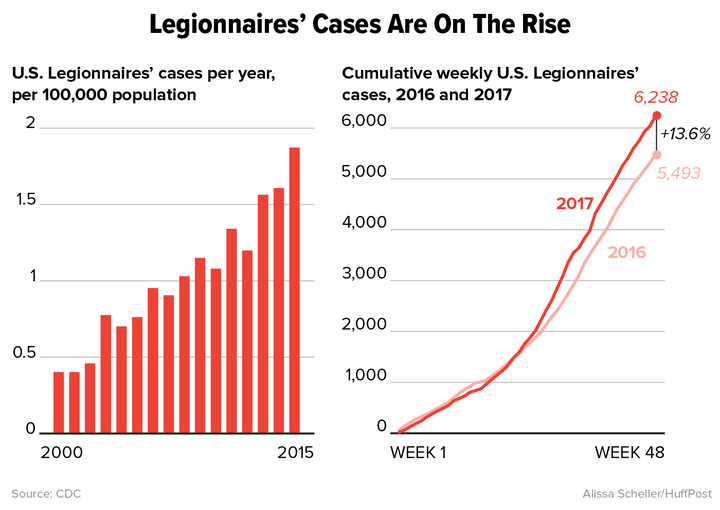
Legionnaires’ Disease Is Rising At An Alarming Rate In The U.S.
Health officials are increasingly concerned about the continuous uptick of Legionnaires’ disease cases, which have risen steadily since 2000.
While the waterborne bacterial disease is relatively rare ― with 6,238 cases nationwide so far this year ― there has been a 13.6 percent increase in cases since this time last year. That’s nearly double the increase of 7.8 percent from 2015 to 2016 in the same time period.
The disease is not contagious. It’s contracted when people breathe in water droplets contaminated with Legionella pneumophilia bacteria.
“A person acquires Legionnaires’ disease from mist,”Julien Martinez, assistant press secretary at the New York City Department of Health and Mental Hygiene, told HuffPost in October. “Most cases of Legionnaires’ disease can be traced to plumbing systems where conditions are favorable for Legionella growth, such as cooling towers, whirlpool spas, hot tubs, humidifiers, hot water tanks and evaporative condensers of large air-conditioning systems.”
For most people, Legionnaires’ disease is treatable with antibiotics, but it can cause severe respiratory illnesses or pneumonia and is fatal for about 1 out of every 10 people who contract it, according to the U.S. Centers for Disease Control and Prevention.
Experts point to a handful of factors when looking at the upward trend. The nation’s aging population, which is more susceptible to the disease, and deteriorating infrastructure are top of the list. And the increased awareness of the disease and improved detection are contributing to the rise in identified cases, Dr. Chris Edens, an epidemiologist on CDC’s Legionella team, told HuffPost.
Edens also pointed to the rise in temperatures nationwide ― with longer summers meaning more usage of cooling towers ― as another potential factor in the increase.

A New York Problem
While cases are up nationally, New York City and state are seeing a particularly steep jump ― with a 78 percent increase and 34 percent rise, respectively, according to the CDC. The city had seen more cases this year that it did in 2015, when it faced the “worst outbreak in its history,” Tonya Winders, CEO and president of Allergy & Asthma Network, part of the Alliance to Prevent Legionnaires’ Disease, told HuffPost in a statement.
Martinez attributed the continued rise to the national trend as well as the city’s population density and the growing awareness following a Bronx outbreak in 2015.
But the uptick this year is following an extensive effort after the Bronx outbreak to combat potential Legionnaires’ cases, including becoming the first U.S. municipality to mandate cooling tower maintenance requirements.
“To enforce the regulations, the department hired over 60 staff; trained City personnel; increased surveillance capacity to rapidly detect and respond to potential Legionnaires’ disease clusters; and enhanced the New York City Public Health Laboratory’s ability to detect and characterize Legionella bacteria from cooling tower water samples,” Martinez told HuffPost in an email Monday.
For Winders, however, the numbers show that New York’s efforts have not been enough.
“Until New York starts testing and studying Legionella bacteria in the water system and applies system-level solutions, we do not believe they will see a reduction in Legionnaires’ disease cases anytime soon.”

A National Issue
New York is not alone: A high-profile outbreak at Disneyland in California captured major media attention last month. The rise of cases in Connecticut ― which has seen cases nearly double ― and Ohio and Florida ― which have seen an increase of over 100 cases each ― is also cause for concern.
CDC efforts to ramp up guidelines for building owners combined with increased outreach to state and local health departments to identify connected cases could be vital to bringing down the cases, according to Edens.
“We really do believe that attacking it on all these fronts is the way to bend the curve down the road,” he said.
But fixing aging infrastructure to protect an aging population is no easy matter, Dr. Oscar Alleyne, the current senior adviser for public health at the National Association of County and City Health Officials, told HuffPost. Alleyne previously served for 16 years in epidemiology and county health planning in New York.
“If you look at the growth of population in comparison to what is necessary to control or at least reduce the risk of these kinds of infections, there is an all-hands-on-deck approach needed to seeing what all is there,” he said.
“You tie all these compounding factors together, and you have a recipe for disaster.”
